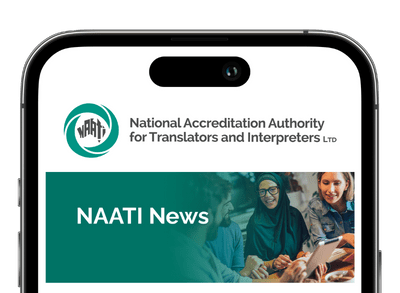NAATI's Certification System
NAATI’s Certification System is designed to evaluate whether an individual is competent to practise as a translator. It does this by setting minimum standards of performance across a number of areas of competency. Individuals who demonstrate that they meet these standards are awarded NAATI certification. This gives assurance to both the users and the interpreting service provider that the interpreter has the necessary competencies to carry out the interpreting task.
NAATI’s system consists of the following two categories:
Certified includes Certified Translator and Certified Advanced Translator. These certifications are typically available between English and a Language Other Than English (LOTE) for which NAATI assesses all significant competencies directly and objectively. Commensurate with the level of certification, translators work with documents from certain typical domains and types.
Recognised Practising is available between English and a LOTE for which NAATI currently does not offer certification testing, e.g. for emerging or low demand languages. NAATI directly assesses Language Competency (English), Intercultural Competency and Ethical Competency, but is only able to indirectly confirm other competencies through evidence of work experience. In the absence of translators with certification for a language, Recognised Practising Translators may be asked to translate documents from the same domains and of the same types as certified translators.
Descriptors for translating
The Descriptors for Translator Certifications outlined below have been developed for the purpose of NAATI Certification. They outline the expected minimum standard of performance translators display across the competencies required for professional practice, while taking into account the characteristics of translators’ work environments.
The descriptors assist potential candidates for certification and users of translation services to gain a general understanding of expected translator competencies. The descriptors are not intended to reflect the complexity of the certification system.
This competency is indirectly confirmed.
Comprehends and produces non-complex texts in English across a variety of text types, appropriately using non-specialised language and commonly used expressions. LOTE proficiency is indirectly confirmed.
This competency is indirectly confirmed.
Operates in the translation industry and manages interactions with clients to provide services.
In the absence of translator certification for a language, Recognised Practising Translators may be asked to translate the same document types as certified translators.
Transfers complex, non-specialised texts from a source language into a target language text that accurately reflects the meaning.
Comprehends and produces complex texts in two languages across a variety of text types, appropriately using non-specialised and complex language and commonly and uncommonly used expressions.
Can use a variety of research tools and methods to search for information, including specialist resources, and is able to extract and manage complex information from research and apply it to the translation task.
Operates in the translation industry and manages interactions with clients to provide services.
Personal documents (e.g. passports, licences, education certificates), government (e.g. brochures, website content), legal (e.g. contracts, wills, court documentation), health (e.g. brochures), technology (e.g. manuals, product information), business (e.g. letters, marketing material), community (e.g. brochures), education (e.g. letters, school policies), tourism (e.g. leaflets, museum publication), finance (e.g. reports, financial statements), consumer affairs (e.g. brochures, product information), insurance (e.g. policies, reports), culture (e.g. magazine articles), science (e.g. reports), commerce and economics (e.g. policy documents).
Transfers highly complex, specialised texts from a source language into a target language text that accurately reflects the meaning.
Comprehends and produces complex texts in two languages across a variety of text types in specialised domains, appropriately using specialised and complex language including technical expressions and jargon.
Can use a variety of research tools and methods to search for information, including highly specialist resources in a variety of domains, and is able to extract and manage specialised and complex information from research and apply it to the translation task.
Operates in the translation industry and manages interactions with clients and other translators to provide services.
All domains and document types a Certified Translator deals with, plus politics (e.g. government submissions), diplomacy (e.g. international agreements), legal (e.g. high court documentation), health (e.g. conference papers), technology and science (e.g. textbooks, scientific works), business (e.g. international business agreements), finance (e.g. academic articles), commerce and economics (e.g. international trade documentation).
